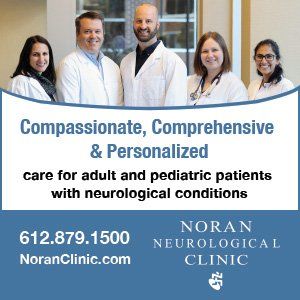or the first time since 1918, the average U.S. life expectancy declined for four consecutive years. Just as our lifespan is shortening, so is our healthspan due to the earlier onset of chronic illnesses. Behavior and lifestyle choices contribute significantly to the decline in healthspan, but the risk for diseases—from heart disease and lung disorders to addiction and depression—can be reduced by optimizing brain development in the first 1,000 days of life, beginning at conception. A small investment during this time, as simple as better nutrition, parental education, and community support, can reap huge benefits over a child’s life, something we all benefit from. As a broader community, we would be well served to better support parents and caregivers who are struggling.
cover story two
The Itasca Project
Improving the First 1,000 Days of Brain Development
By Jakub Tolar, MD
The Itasca Project is a cross-sector alliance of Minneapolis-St. Paul-area employers who are drawn together by an interest in new and better ways to address regional issues that impact future economic competitiveness and quality of life. The University of Minnesota Medical School is a member of the Itasca Project, and I am a co-chair of the First 1,000 Days task force.
Roger Thurow, author of “The First 1,000 Days: A Crucial Time for Mothers and Children—And the World,” writes, “If we want to shape the future, to truly improve the world, we have 1,000 days to do it, mother by mother, child by child, for what happens in those 1,000 days through pregnancy to the second birthday determines, to a large extent, the course of a child’s life, his or her ability to grow, learn, work, succeed and by extension, the long term health, stability and prosperity of the society in which that child lives.”
During the first 1,000 days, the brain is very plastic, changing and rewiring itself.
Why we focus on the first 1,000 days
The roots of malnutrition, disease, suboptimal academic development and inequality are often found in the first 1,000 days and unequal access to prenatal care. Failing to nourish strong beginnings results in persistent poverty and worsening inequality, as well as higher healthcare costs and weaker economies. Disparities across socioeconomic status first appear at just 18 months of age because when parents and families have to focus on basic needs, babies have less enriching environments. Health disparities are prominent and can form a life’s trajectory by age five.
As physicians, we know nutrition, healthcare, parenting and environmental safety, among other experiences, physically shape the connections in the brain, building the foundation for higher-level processing which happens later. Sensory functions start to develop before birth. Language development begins in the first year, followed soon after by higher cognitive functions. This progression requires providing the right conditions for development at the right times and avoiding conditions that hinder brain development.
During the first 1,000 days, the brain is very plastic, changing and rewiring itself, which is why this time period is a critical time for development, as well as intervention and treatment. Joint research by the University of Minnesota Medical School and the University of North Carolina is using advanced imaging technologies to develop the Baby Connectome—a specific map of neural connections and their evolution. The research shows that as children get older their brains become less plastic because many of the foundational pathways for vision, hearing, language, emotion and attention have already been laid down. By age four or five, there is still significant brain development to come, but it will be profoundly affected by the foundational architecture already established.
Neuroscience research has shown that stress negatively affects brain development. Financial and food insecurity, housing instability, and exposure to violence are common sources of stress for children and families of low socioeconomic status that have a clear negative impact on brain development. These adverse childhood experiences can be found in nearly one in six adults and are linked directly to negative outcomes later in life, including an increased risk of obesity, heart disease and depression. According to the Centers for Disease Control and Prevention, researchers estimate that up to 1.9 million cases of heart disease and 21 million cases of depression could be avoided by preventing early adverse experiences.
Lower socioeconomic status is also associated with lower total gray matter, which contains most of the brain’s neurotransmitters. Lower total gray matter volume is associated with behavioral problems such as rule breaking, excessive aggression and hyperactivity as early as age four. Later in life, lower gray matter is associated with higher risk for mental illnesses, such as depression and anxiety.
Building awareness and compassion around social determinants of health
COVID-19 disproportionately impacted some of our communities of color, largely due to chronic health problems which have been created by lifetimes of inadequate access to healthy food, safe exercise and quality preventative care, as well as the stresses created by economic and other inequities.
At our Broadway Family Medicine Clinic in North Minneapolis, care providers have long understood how communities are impacted by what we call social determinants of health. Led by faculty member Shailey Prasad MD, MPH, this clinic, its providers, staff and resident learners, created a space for ongoing conversations about social determinants of health and to connect resident physicians with partners and allies in health advocacy. In 2012, Prasad started the Community Health & Advocacy Talks or CHAT, monthly meetings to discuss everything related to health except clinical care. Over nearly 10 years, the group has engaged a broad range of speakers covering a diverse list of subjects, from then-mayor R.T. Rybak addressing the achievement gap in Minneapolis to former gang member John Turnipseed discussing the connection of generational violence and attention deficit disorder.
Hanna Nedrud, MD, a current resident in the North Memorial Family Medicine Residency Program and CHAT participant and program manager said, “Medical training focuses largely on disease processes within the body and how we can address them within clinics and hospitals. Yet...in my practice, I need to pay attention to the environment outside the clinic, be informed about resources for my patients and use my power and privilege as a physician to advocate for positive change.”
This and other initiatives teach us to develop close two-way relationships which position us not as experts teaching, but as a resource listening and responding to the needs of the community. Improving health equity will take all of us both in and outside of medicine—it will also require every one of us to do what we can to ensure healthy pregnancies and in turn healthy starts for children.
Stress negatively affects brain development.
The Masonic Institute for the Developing Brain
At the new Masonic Institute for the Developing Brain (MIDB), led by the Medical School and College of Education and Human Development, we are bringing together researchers and clinicians across the University of Minnesota to focus on childhood brain development from many different areas of expertise and focusing on the needs brought by our community. We will use what we know and what we learn to help children by creating better assessment tools to identify neurobehavioral and mental health issues early in life, by developing interventions that target these early stages, by informing public policy, by educating our communities and by advocating for the millions of children who cannot speak for themselves.
While MIDB will work with children of all ages, the institute will have a strong focus on the first 1,000 days. Research shows by intervening in the first 1,000 days, we can make an impact on each child’s potential for a healthy, happy and successful life. Yet too few parents, caregivers, educators, social workers and even some clinicians realize the critical effects of those early years and their lifelong impact on future health and education outcomes.
Defining the initiative
Given the complexity of social determinants of health, focusing on the first 1,000 days needs to be a community-wide initiative. to ensure parents and caregivers have what they need in their children’s first 1,000 days. Minnesota’s business community has long been aware of the connection between early childhood development and long-term outcomes. It has been 18 years since former Federal Reserve economist Art Rolnick released a report, “Early Childhood Development: Economic Development with a High Public Return,” sparking conversations around the globe about the economic return of early childhood development, specifically high-quality preschools.
Neuroscience research tells us we need to start even sooner.
In 2021, the Itasca Project released a report, “First 1,000 Days: Invest When It Matters Most,” to encourage employers to promote practices and policies that support optimal early experiences for children. The report defined four major factors in optimal brain development during the first 1,000 days that offer opportunities for intervention: health and wellness, knowledge and skills, community resources and support, and social determinants of health.
Health and wellness: Ensure all families have access to prenatal care, improve pregnant mother and infant nutrition, create conditions that encourage breastfeeding and expand support for family mental and emotional health.
Knowledge and skills: Provide parent education and training, deploy electronic communication to reinforce good habits, and expand home visits with nurses and social workers. Most parents do not realize that the moments of connection and interactions in those first 1,000 days have a tremendous and lasting impact on their child’s future.
Community resources and support: Increase available higher-quality childcare, funding for childcare scholarships and subsidies to expand affordability and elevate the early childhood education ecosystem. Before COVID-19, the Minneapolis-St. Paul region had a critical and growing shortfall of high-quality childcare—demand outpaced supply by 38%—and the cost of care ranked the third highest in the nation.
Social determinants of health: Create jobs with family-sustaining wages, expand job training and placement for workers with low income, expand low-cost housing, ensure healthy food supply and encourage family-friendly practices in the workplace. Many non-clinical, environmental factors like stress on the family, ambient pollution and community safety play roles in stimulating or inhibiting brain development. Environment can even impact DNA, switching genetic factors “on” or “off.”
This fall, the Itasca Project is releasing a toolkit for employers to learn more about how they can support the first 1,000 days, including resources for parent and caregiver education. Employers are an often overlooked stakeholder in early childhood development. However, considering that 75% of mothers work outside of the home, employers are a critical partner to help improve the circumstances of children in those first 1,000 days of life.
A statewide social focus
Through the First 1,000 Days Initiative, the Itasca Project is joining Little Moments Count, a Minnesota-based statewide movement to help parents, caregivers and the community understand the importance of talking, playing, reading and singing with infants and toddlers for brain development. This work is being done in close partnership with the MIDB. Little Moments Count is a cross-sector collaboration of organizations focused on reaching parents across cultural communities with an aim to increase equity. The Itasca Project will lead the movement’s employer-focused engagement efforts.
Conclusion
Real change will come when we can collectively improve childhood experiences in the first 1,000 days of life and the early years of brain development. We need physicians and health systems to have access to meaningful resources for parents and children, as well as networks of non-profit organizations equipped to deal with the social determinants of health for families. Getting involved with Little Moments Count and the MIDB is a way to increase access to usable information for patients and families as they work to ensure their child has the best chance at success in life.
We invite you to join us in making a difference and giving the next generation the best chance at a healthy, fulfilling life.
Jakub Tolar, MD,
is Dean of the University of Minnesota Medical School and co-chair of the Itasca Project’s First 1,000 Days Initiative.
MORE STORIES IN THIS ISSUE
















